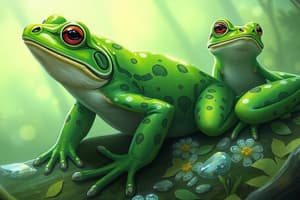Podcast
Questions and Answers
What is a characteristic feature of amphibians?
What is a characteristic feature of amphibians?
- They undergo metamorphosis during their life cycle. (correct)
- They can only live in water environments.
- They possess feathers for insulation.
- They lay eggs on land only.
Which of the following groups is classified as an amphibian?
Which of the following groups is classified as an amphibian?
- Turtles
- Lizards
- Snakes
- Frogs (correct)
Where are amphibians primarily found during their adult life stage?
Where are amphibians primarily found during their adult life stage?
- Mainly in terrestrial habitats (correct)
- Only in tropical regions
- In deep ocean waters
- Exclusively in freshwater habitats
Which physiological feature is a typical adaptation for amphibians?
Which physiological feature is a typical adaptation for amphibians?
What role do amphibians play in ecosystems?
What role do amphibians play in ecosystems?
Flashcards are hidden until you start studying
Study Notes
Characteristics of Amphibians
- Amphibians typically possess moist skin that plays a vital role in respiration and hydration.
- They undergo metamorphosis, transitioning from aquatic larvae (like tadpoles) to terrestrial adults.
Classification of Amphibians
- Major groups classified as amphibians include frogs, toads, salamanders, and newts.
- Amphibians are distinguished from reptiles, birds, and mammals due to their unique life cycle and skin characteristics.
Habitat of Adult Amphibians
- Adult amphibians are primarily found in terrestrial environments such as forests, grasslands, and wetlands.
- They often require proximity to water bodies for reproduction and development of young.
Physiological Adaptations
- Amphibians exhibit skin adaptations that allow for cutaneous respiration, enabling gas exchange through the skin.
- Their permeable skin necessitates a moist environment to prevent desiccation.
Ecological Role of Amphibians
- Amphibians serve as both predators and prey within ecosystems, contributing to food webs.
- They act as bioindicators, reflecting the health of their environments due to their sensitivity to pollutants and habitat changes.
Studying That Suits You
Use AI to generate personalized quizzes and flashcards to suit your learning preferences.




